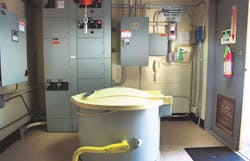California Resort Community Wipes Out Pump Clog Problems
The main culprit causing regular pump clogs in the community of Big Bear City, Calif., is one that occurs all too often in collection systems across the nation: consumer flushables.
“Nine times out of 10, when we pulled a pump it would be clogged with rags, just clogged full of them,” said Andy Keller, sewer department foreman, who estimated that the most problematic of the seven underground pump stations he and his staff operate was clogging up as many as three to four times a week.
Located in the mountains of Southern California at 6,500 ft elevation, Big Bear City is a year-round resort community that is a popular destination for fishing and boating in the summer, and skiing and snowboarding in the winter. Its collection system has more than 12,000 connections and employs eight certified wastewater operators.
Compounding the clogging problem at the resort town was the wildly fluctuating population, which can quadruple on many weekends. During those bumps, pump clogs often would come one right after another, and because many occurred on the weekends, it meant overtime hours paid to service workers.
The clogging problems also prevented Keller’s department from proactively operating and maintaining other parts of the collection system, including 116 miles of pipe, two Vactor trucks and two closed-circuit television vans.
“We were trying to find some sort of solution to help us with that issue so that we weren’t pulling pumps as often ... to try and cut down on the maintenance and the overtime,” Keller said.
Inconvenient Flushables
It is a story that is all too common for collection systems across the nation. The flushables industry has been on the rise with its convenient and effective cleaning tools. The problem is that these popular products work well and flush easily, but their strong, fibrous composition does not mix well with wastewater pumps equipped with standard multi-vane impellers. Inside, the fibrous materials and rags build up, creating imbalances and ultimately clogs that halt operation.
“We’re not the only one having this issue,” Keller said. “Some of these things should be going in the trash and not down the drain.”
After consultation with a representative from Smith & Loveless, the city purchased X-PELLER impellers for three problematic stations. The impellers’ mono-port design helps to counterbalance hydraulic forces and create a balanced, single-flow path that easily passes 3-in. solids and problem flushables. Installation required a simple change in the rotating assemblies.
With more than a year in operation, pump clogs have been eliminated.
“We’ve not pulled a pump [since],” Keller said. “We’re definitely impressed.”
The X-PELLER is designed for both 4-in. (flow from 75 to 500 gal per minute 9 [gpm]) and 6-in. pumps (flow from 200 to 1,000 gpm); and it can operate at 900, 1,200 or 1,800 rpm. Every impeller is custom-trimmed to the application’s particular conditions. They be used with other vertical pump brands if the rotating assembly is replaced.
The elimination of clogging problems has offered many benefits to Big Bear City. Operational costs are down overall, and maintenance workers are freed up to work on other equipment.
“We’ve just been really happy with the product,” Keller said. “They’ve been great to us since the mid-’70s and I highly recommend the X-PELLER.”
Download: Here
